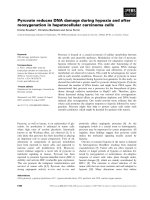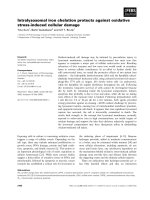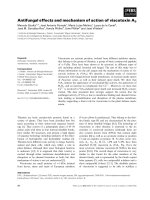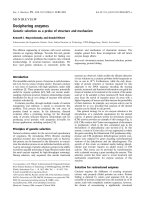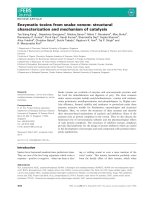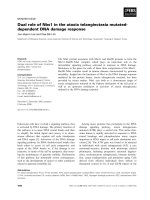Oxidative and nitrosative DNA damage occurrence, measurement and mechanism
Bạn đang xem bản rút gọn của tài liệu. Xem và tải ngay bản đầy đủ của tài liệu tại đây (2.25 MB, 192 trang )
OXIDATIVE AND NITROSATIVE DNA DAMAGE:
OCCURRENCE, MEASUREMENT AND MECHANISM
LIM KOK SEONG
(B.Sc. (Hons) Pharmacy, Strathclyde, UK)
A THESIS SUBMITTED
FOR THE DEGREE OF DOCTOR OF PHILOSOPHY
DEPARTMENT OF BIOCHEMISTRY
NATIONAL UNIVERSITY OF SINGAPORE
2005
i
FOREWORD
The biggest worry that I had during the past four years while I was studying abroad is
my 89-year-old grandmother.
“Grandma, what would happen to me if you leave?” I tearfully asked her.
“Don’t worry; I will always be there for you.”
Twenty years have passed, and I had unknowingly believed in what she said since I
was a child. My grandmother is the one who looked after me from the day I was born,
who guided me along the way in life, who shared with me her happiness and sadness
at all times, whom I relied upon when I needed someone to talk to - the very one who
gave me a sense of contentment and security in life.
November 2004 - it began as another ordinary month - the fortieth month after I first
left home for PhD study, the time finally came for me to start preparing this thesis.
Just when I kept thinking that I would soon be able to go accompany my grandmother
again back home, she passed away quietly, leaving me in sorrow. Four-year is not
long, but too long for her.
I would like to dedicate this thesis to my grandmother who left this world on the 27th
November 2004. From an ignorant child to an understanding adult, I feel blessed that
I had a loving grandmother who had been my friend, my mentor and my guardian in
ii
life. For being everything she had been and helping me to become everything I can be,
she has my everlasting love.
iii
ACKNOWLEDGMENTS
Hidden between lines and figures of this thesis is a story - a story of adventure,
friendship, love, gratitude and maturation - another chapter of my book of life. The
story began four years ago when I approached a laboratory labeled “Oxidant and
Antioxidant Laboratory”, surveyed it from a distance and imagined how a scientist
would do experiment behind the blue doors. Not even knowing much about a Gilson
pipette (and certainly unaware that scientific research work is very much dependent
on performance of this amazing gadget), I asked the “boss” about the possibility of
working in the laboratory as a student. I have been in since then. Now, four years later,
this story, which has been made possible by many wonderful people behind this blue-
turned-brown door, is coming to its end. I would like to thank all those people who
made this thesis possible and an enjoyable experience for me.
My deepest gratitude to my supervisor, Prof. Barry Halliwell who has given me the
chance to participate in this research project. His invaluable advice, consistent support
and encouragement have made the work on this thesis an inspiring, sometimes
challenging, but always interesting experience. His time, understanding and patience
meant a lot to me. The journey through the graduate study has been very enriching,
and I am honored for the opportunity to work in his laboratory.
I am very grateful to Dr. Andrew Jenner and Ms. Huang Shan Hong for sharing their
invaluable experience and advice on GC/MS. My special thanks to Mr. Wang
Huansong for his technical advice on HPLC in the later part of the project, and for the
iv
many enjoyable and fruitful discussions and sharing of insights on life as well as
research, which have made my final year in graduate study a very memorable one.
I would also like to express my sincere thanks to Prof. Kandiah Jeyaseelan and Dr.
Arunmozhiarasi Armugam for the pleasant discussions and continuous support while I
worked on the molecular biology aspect of mitochondrial DNA. I am also grateful to
Dr. Matthew Whiteman and Prof. Sit Kim Ping for their ideas and advice throughout
the course of the study.
My appreciation to Ms. Long Lee Hua for her help in the past few years, and all other
former and current members of antioxidant laboratory as well as those at “Annex”
(MD 4A) for their comradeship and assistance, especially to Dr. Peng Zhaofeng, Jia
Ling, Soon Yew, Yvonne, Charmian, Yimin and Dr. Jan Gruber.
My most heartfelt thanks to my beloved family for always being there when I needed
them most, and never once complaining about how infrequently I visit, they deserve
far more credit than I can ever give them. Their encouragement has turned my journey
through graduate study into a pleasure.
v
TABLE OF CONTENTS
Foreword i
Acknowledgments iii
Table of Contents v
Summary xii
List of Tables xiv
List of Figures xv
Abbreviations xx
CHAPTER 1 INTRODUCTION 1
1.1 Reactive Species Derived from Oxygen and Nitrogen 1
1.1.1. The Chemistry of Reactive Oxygen Species 1
1.1.2. The Sources of Reactive Oxygen Species 2
1.1.3. The Chemistry of Reactive Nitrogen Species 5
vi
1.1.4. The Sources of Reactive Nitrogen Species 7
1.2 Oxidative and Nitrosative Damage in DNA 8
1.2.1. DNA damage Induced by Reactive Oxygen Species 8
1.2.2. DNA Damage Induced by Reactive Nitrogen Species 14
1.3 Mutagenicity of Oxidative and Nitrosative DNA Damage Products 17
1.4 Methods Used in the Quantitative Study of Oxidative and Nitrosative DNA
Damage 18
1.5 Aims of this Study 22
1.5.1. Oxidative Damage in Mitochondria and Nuclei 22
1.5.2. Artefacts in the Study of Oxidative Damage in Mitochondrial DNA 24
1.5.3. Detection and Measurement of DNA Deamination Products 25
CHAPTER 2 MATERIALS AND METHODS 28
2.1 Chemicals 28
2.2 Animals 30
2.3 Isolation of Pure Mitochondrial DNA, Nuclear DNA and Total Cellular
DNA 31
2.3.1. Separation of Organelles 31
2.3.2. Isolation of DNA 32
vii
2.3.3. Separation of DNA 33
2.3.4. A Modified Method 34
2.4 Characterization of the Pure Mitochondrial DNA and Nuclear DNA 35
2.4.1. Verification of Purity of mtDNA 35
2.4.2. Restriction Digestion of DNA 36
2.4.3. Agarose Gel Electrophoresis 36
2.4.4. Quantitation of DNA 37
2.5 Isolation of Coupled Mitochondria 37
2.6 Analysis of Oxidative Damage End Products 39
2.6.1. Oxidative DNA Damage 39
2.6.1.1. DNA Sample Pooling 39
2.6.1.2. GC/MS Analysis of DNA Bases 39
2.6.2. Oxidative Protein Damage 40
2.6.2.1. Preparation of Subcellular Protein Extracts 40
2.6.2.2. Determination of Protein Carbonyl Content 41
2.6.3. Lipid Peroxidation 42
2.6.3.1. Determination of Malondialdehyde Content 42
2.6.4. Time Course Study 42
2.7 Analysis of Oxygen Consumption and H
2
O
2
Production by Mitochondria43
2.7.1. Measurement of H
2
O
2
Produced by Mitochondria 43
2.7.2. Oxygen Consumption by Mitochondria 44
2.7.3. H
2
O
2
Scavenging Activity in Subcellular Compartments 44
2.8 Analysis of Nitrosative DNA Damage End Products 45
2.8.1. Enzymatic Hydrolysis of DNA 45
2.8.2. Isolation and Analysis of Nucleoside using HPLC 45
2.8.3. GC/MS Analysis of Nucleosides 46
2.8.4. In vitro DNA Deamination 47
viii
2.9 Analysis of Nitric Oxide End Products 47
2.9.1. Griess Assay of NO
2
⎯
and NO
3
⎯
47
2.10 Statistical Analysis 48
CHAPTER 3 ANALYSIS OF OXIDATIVE
DAMAGE IN MITOCHONDRIAL AND
NUCLEAR DNA 49
3.1 Results 49
3.1.1. Isolation and Characterization of Pure Mitochondrial DNA 49
3.1.1.1. Isolation of Pure Mitochondrial DNA 49
3.1.1.1.1. Separation of Organelles 51
3.1.1.1.2. Separation of DNA 53
3.1.1.1.3. A Modified Protocol 55
3.1.1.2. Characterization of Pure Mitochondrial DNA 56
3.1.1.3. Verification of Purity of the DNA 59
3.1.2. Oxidative Damage in Mitochondrial and Nuclear DNA 60
3.1.2.1. Comparison between Phenol and DNAzol Method 60
3.1.2.2. Comparison between Mitochondrial and Nuclear DNA 61
3.2 Discussion 66
ix
3.2.1. Isolation and Characterization of Pure Mitochondrial DNA 66
3.2.2. Oxidative Damage in Mitochondrial and Nuclear DNA 71
3.2.2.1. Inefficient Mitochondrial DNA Repair? 75
3.2.2.2. Ex Vivo Damage to Mitochondrial DNA? 76
3.2.2.3. In Vivo Damage to Mitochondrial DNA? 77
CHAPTER 4 IS THERE EX VIVO PRODUCTION
OF HYDROGEN PEROXIDE AND
OXIDATION OF BIOMOLECULES
DURING ISOLATION OF
MITOCHONDRIA? 80
4.1 Results 80
4.1.1. Is there Artefactual Oxidation of DNA during Isolation? 80
4.1.2. Is there Release of H
2
O
2
from the Rat Mitochondria during Isolation? 83
4.1.3. Is there Artefactual Oxidation of Protein and Lipid during Isolation? 97
4.1.4. Protein Carbonyl in Subcellular Compartments 101
4.2 Discussion 104
x
4.2.1. Is there ex vivo Production of H
2
O
2
and Oxidation of Biomolecules during
Isolation? 104
4.2.2. Protein Carbonyl in Subcellular Compartments 107
4.2.3. How Significant is the in vivo Production of H
2
O
2
and Oxidation of Biomolecules?
109
CHAPTER 5 MEASUREMENT OF 2’-
DEOXYINOSINE IN DNA BY GAS
CHROMATOGRAPHY-MASS
SPECTROMETRY 112
5.1 Results 112
5.1.1. Formation of Xanthine and Hypoxanthine during Acid Hydrolysis 112
5.1.2. Development of GC/MS Assay for the Detection of 2’-Deoxyinosine and 2’-
Deoxyadenosine 115
5.1.3. Enzymatic Hydrolysis of DNA to Release Nucleosides 121
5.1.4. GC/MS Analysis with HPLC-Prepurification of Nucleosides 123
5.1.5. Artifacts Associated with the GC/MS Analysis of Nucleosides 126
5.1.5.1. Interference from 2’-Deoxyguanosine Contamination 126
xi
5.1.5.2. Artefactual Formation of 2’-Deoxyinosine during Enzymatic Hydrolysis
127
5.1.6. Formation of 2’-Deoxyinosine in DNA Treated with Micromolar Nitrous Acid128
5.1.7. Lipopolysaccharide-Treated Rat – an Animal Model of Nitrosative Stress 129
5.1.8. Lipopolysaccharide-Treated Rat – an Animal Model of Oxidative Stress 132
5.2 Discussion 135
5.2.1. Development of GC/MS Assay for the Detection of 2’-Deoxyinosine 135
5.2.2. Lipopolysaccharide-induced DNA Damage in Rat 137
CHAPTER 6 CONCLUSION 140
REFERENCES 142
xii
SUMMARY
Mitochondrial DNA (mtDNA) has long been believed to suffer greater endogenous
oxidative damage than nuclear DNA (nDNA) because of its close proximity to the
free radical generation sites in the mitochondria. However, the large variation among
the damage levels published by several laboratories (mostly measured as either 8-
hydroxyguanine or 8’-hydroxy-2’-deoxyguanosine) has led most investigators to
suggest that artefacts are formed in these studies. These possible artefacts have cast
doubt on the validity of the various methods used to study DNA damage. The theory
that mtDNA is more heavily damaged than nDNA therefore does not stand on firm
ground. As mitochondrial DNA constitutes only 1% of the total cellular DNA, we
have, in this study, obtained mtDNA of desired purity in order to make a valid
comparison of oxidative damage between mtDNA and nDNA. Our data show that a
possibility exists that mtDNA damage is not higher than nDNA damage, confirming
the results of the previous study by Anson et. al. (1999). In contrast, we demonstrate a
higher level of 8-OH Guanine in nDNA than in mtDNA. Three other lesions – Fapy
Guanine, Fapy Adenine and 5-OH Cytosine were found to be statistically significantly
higher in nDNA than in mtDNA.
In view of the great variation among the reported damage levels, several possibilities
of ex vivo artefactual oxidation have been suggested to explain the observed high
levels of damage in mtDNA if the mtDNA damage has been overestimated. These
include analysis of small quantities of DNA, cross contamination of nDNA and
mtDNA and artefactual oxidation of DNA during isolation of mitochondria. Our study
xiii
shows that artefactual oxidation of biomolecules during isolation of mitochondria
does not appear to occur. In the isolation of rat liver mitochondria, generation of
hydrogen peroxide was not found to occur and artefactual oxidation of protein was
observed to be minimal, if not absent. Nor was total DNA and lipid oxidation
observed in tissue homogenate. Our results suggest that if rat liver mitochondria do
produce ROS physiologically, these ROS are mostly scavenged by antioxidant
defense systems and little or no H
2
O
2
escapes to cause damage to biomolecules.
Acid hydrolysis of DNA is commonly carried out to release DNA bases for analysis
by GC/MS, but artefactual formation of DNA deamination products during this
process has rarely been studied. In the study of DNA deamination, we demonstrate
the occurrence of artefactual formation of 2’-deoxyinosine during the process of DNA
hydrolysis by hot formic acid, and thereafter, developed an improved GC/MS method
to detect and measure 2’-deoxyinosine.
xiv
LIST OF TABLES
Table 1 Salmon testis DNA (control DNA) was re-extracted using phenol or DNAzol method and
analyzed using GC/MS. Each data point represents the mean ± sd for four independent
preparations. 5-formyl uracil and 2-OH adenine were present at levels that are too low for
detection 60
Table 2 Oxidative base damage products in mtDNA and nDNA isolated from rat liver tissue using
modified DNAzol method. Approximately 80 rats were sacrificed, the livers were removed for
DNA extraction, and nDNA and pure mtDNA samples from 5-8 rats were pooled to give 11
DNA samples for analysis. Each data point represents the mean ± sem for 11 samples from two
independent experiments. 5-Formyl Uracil and 2-OH Adenine were present at levels that were
too low for detection. 61
Table 3 Oxidative base damage products in pure mtDNA, cmDNA and nDNA isolated from rat liver
tissue using modified DNAzol method. Each data point represents the mean ± sd for at least
five independent preparations. 5-formyl uracil and 2-OH adenine were present at levels that
are too low for detection. 65
Table 4 Four methods used in the previous studies on oxidative damage in mitochondrial and nuclear
DNA 67
Table 5 Comparison of levels of 8-OHdG or 8-OH Guanine in mtDNA and nDNA from several
studies. Conversion factor used is 1nmol of 8-OHdG/mg DNA equals to 318 8-OHdG/10
6
DNA
bases (Halliwell, 1999) 74
Table 6 Comparison of 2’-deoxyinosine levels in DNA from 2 organs in both control and LPS-treated
rats. 50mg/kg LPS was injected intravenously into Sprague-Dawley rats (n=4) and the animals
sacrificed 4-5hr after injection. DNA was isolated using DNAzol from liver and kidney for
analysis by GC/MS. The levels of 2’-deoxyinosine in both the hepatic and renal DNA of LPS-
treated rat was not found to be significantly higher when compared to that of control rat. Each
data point represents the mean ± S.D. for four independent samples 130
xv
LIST OF FIGURES
Figure 1 Chemical structures of thymine and its oxidized derivatives 10
Figure 2 Chemical structures of cytosine and its oxidized derivatives 12
Figure 3 Chemical structures of guanine and adenine with their oxidized derivatives 13
Figure 4 Formation of deaminated DNA base products. 16
Figure 5 Determination of detection limit of the PCR profile using serial dilutions of nDNA as
standards (A). A calibration curve based on the intensity of the β-actin bands was plotted (B).
As low as 0.3ng of nDNA would be amplified to give a distinct β-actin band after 27 cycles of
PCR, giving rise to a detection limit of approximately 3% if 10ng DNA sample is used in the
verification of purity. 51
Figure 6 Mitochondria from rat liver were isolated by differential centrifugation (A) and further
purified by Percoll density gradient centrifugation (B). DNA isolated from mitochondrial
fraction (mt) or nuclear fraction (n) using phenol method was used as template for primers
specific to the cytochrome b gene (a) and the β-actin gene (b) 52
Figure 7 Mitochondria from rat liver were isolated by differential centrifugation and further purified
by Percoll density gradient centrifugation. The solution was divided from top to bottom of the
centrifuge tube into 29 fractions and DNA isolated from each fraction using phenol method was
used as template for primers specific to the cytochrome b gene (a) and the β-actin gene (b).
Only 1 fraction (2nd fraction) contains pure mtDNA. Shown are the representative gels from
two independent experiments. 53
Figure 8 Total cellular DNA was isolated using phenol method from rat liver and mtDNA separated
by CsCl discontinuous gradient centrifugation. Two distinct bands of DNA formed – upper (U)
& lower (L) band. These fractions, together with the fraction between the 2 bands (M), were
used as templates for primers specific to the cytochrome b (a) and the β-actin gene (b). 54
Figure 9 Total cellular DNA was isolated using phenol method from rat liver and mtDNA separated
by CsCl continuous gradient centrifugation. One distinct band of DNA formed and was used as
template for primers specific to the cytochrome b gene and the β-actin 395bp gene. 55
Figure 10 Mitochondria from rat liver were isolated by a modified protocol of differential
centrifugation. mtDNA isolated using DNAzol method was used as template for primers specific
to the cytochrome b gene (467bp) and the β-actin gene (395bp) 56
Figure 11 (A) Restriction enzyme map of rat mtDNA. Restriction site locations are BamH1 9361 and
14436; XbaI 612 and 10891; HindIII 1477, 5608, 7685, 10255, 11065 and 11230. (B) MtDNA
restriction fragments on 0.5% (w/v) agarose gel stained with ethidium bromide 58
Figure 12 nDNA (n1-6) and mtDNA (mt1-6) isolated from rat liver using the modified DNAzol
method were used as templates for primers specific to the cytochrome b gene and the β-actin
gene. nDNA preparations contain both nDNA and mtDNA whereas mtDNA preparations
contain only mtDNA 59
Figure 13 Chromatograms of the target ions of (A) Fapy Guanine and (B) 8-OH Guanine in mtDNA
and nDNA. 62
Figure 14 Restriction fragments of nDNA, cmDNA and mtDNA on 0.5% (w/v) agarose gel stained
with ethidium bromide. 63
xvi
Figure 15 Gel electrophoresis of total cellular DNA isolated from rat liver. Liver tissue homogenate
was incubated for the time periods shown before DNA isolation and gel electrophoresis. No
detectable degradation of DNA was observed. Shown is a representative gel from two
independent experiments 81
Figure 16 Oxidative base damage products in total cellular DNA isolated from rat liver. Liver tissue
homogenate (pooled from 2 rats for each experiment) was incubated for the time periods shown
before isolation and GC/MS analysis of DNA. 5-formyl uracil and 2-OH adenine were present
at levels that are too low for detection. Each data point represents the mean ± sd for at least 3
separate experiments. * The base damage product level at the specified time point is
significantly higher at P<0.05 than that at 0min but this may be a random event as there is no
progressive increase in base damage levels. 82
Figure 17 Rat liver mitochondria isolated using differential centrifugation were tightly coupled with
a RCR of 4.5. Shown is a representative diagram from five independent experiments 84
Figure 18 Detection of H
2
O
2
released from rat liver mitochondria. No release of H
2
O
2
occurs during
isolation. The sudden apparent increase in fluorescence following addition of mitochondria is
due to their effect on the detection system. Shown is a representative diagram from three
independent experiments 84
Figure 19 Monitoring of H
2
O
2
production in rat liver mitochondria isolated by differential
centrifugation. No H
2
O
2
was detected even in the presence of succinate. Shown is a
representative diagram from four independent experiments 85
Figure 20 Monitoring of H
2
O
2
production in rat liver mitochondria isolated by differential
centrifugation followed by Percoll density gradient centrifugation. No H
2
O
2
was detected even
in the presence of succinate. Shown is a representative diagram from two independent
experiments. 86
Figure 21 Scavenging of H
2
O
2
in rat liver mitochondria isolated by differential centrifugation. Shown
is a representative diagram from at least three independent experiments. Refer to text for
details 87
Figure 22 Detection of H
2
O
2
in rat liver mitochondria in the presence of aminotriazole (ATZ).
Preincubation of mitochondria with aminotriazole for the time indicated failed to recover the
H
2
O
2
. Shown is a representative diagram from at least three independent experiments. Refer to
text for details. 88
Figure 23 H
2
O
2
production in rat heart mitochondria isolated by differential centrifugation. H
2
O
2
was detected in the presence of succinate. Shown is a representative diagram from three
independent experiments. Refer to text for details. 89
Figure 24 (A) H
2
O
2
production in rat heart mitochondria isolated by differential centrifugation. H
2
O
2
production was inhibited by ADP. Shown is a representative diagram from two independent
experiments. (B) Effect of respiratory complex inhibitor on H
2
O
2
production. Rotenone
decreases H
2
O
2
production whereas antimycin A increases it. Each data point represents mean
± sd for four independent experiments 90
Figure 25 Rat heart mitochondria isolated using differential centrifugation. Shown is a
representative diagram from three independent experiments 91
Figure 26 Scavenging of H
2
O
2
in rat heart mitochondria. Shown is a representative diagram from at
least three independent experiments. Refer to text for details 92
Figure 27 Scavenging of H
2
O
2
in rat heart and liver mitochondria. Each data point represents mean
± sd for three independent experiments. * Liver mitochondria have significantly higher
scavenging activity at P<0.05 level when compared to heart mitochondria. Refer to text for
details 93
xvii
Figure 28 Scavenging of H
2
O
2
in subcellular fractions of rat heart tissue. Each data point represents
average of two separate samples differing by < 11%. No significant difference in scavenging
activity among the three subcellular fractions was observed at P<0.05 level 93
Figure 29 (A) The increase in fluorescence slows down after a certain time following first addition of
succinate. Shown is a representative diagram from two independent experiments (B) The rate
of H
2
O
2
production by mitochondria declines to nearly 0 after a period of 3hr incubation with
succinate. Each data point represents mean ± sd for three independent experiments 95
Figure 30 Production of H
2
O
2
by mitochondria using different respiratory substrates. Each data
point represents mean ± sd for four independent experiments 96
Figure 31 Protein carbonyl levels in subcellular fractions isolated from rat liver. Liver tissue
homogenate (pooled from 4 rats for each experiment) was incubated for the time periods shown
before isolation and analysis of protein. Each data point represents the mean ± sd for at least
three independent experiments. * The protein carbonyl level in cytosol at 180min is
significantly higher at P<0.05 than that at 0min 97
Figure 32 Protein carbonyl levels in mitochondria isolated from rat liver. Approximately 100mg of
isolated mitochondria (pooled from 4 rats for each experiment) were incubated in the absence
or presence of 200mM succinate for the time periods shown before isolation and analysis of
protein. Each data point represents the mean ± sd for at least three separate experiments. No
significant difference in protein carbonyl content was observed at P<0.05 level at all time
points when compared to that at 0min. * However, the level of protein carbonyl in
mitochondria supplemented with succinate for 4hr was significantly higher (P<0.05) than that
in unsupplemented mitochondria. This may be a random event as there is no further increase in
protein carbonyl levels in the succinate-supplemented mitochondria at 8hr 98
Figure 33 Protein carbonyl levels in mitochondria isolated from rat liver. Isolated mitochondria
were incubated in the absence or presence of succinate, succinate/ADP or succinate/AA at
37°C for 60min before isolation and analysis of protein. Each data point represents the mean ±
sd for three separate experiments. No significant difference in protein carbonyl content was
observed at P<0.05 level among them 99
Figure 34 Protein carbonyl levels in mitochondria isolated from rat heart. Isolated mitochondria
were incubated for the time periods shown before isolation and analysis of protein. Each data
point represents the mean ± sd for at least three separate experiments. Protein carbonyl level
at 8hr is significantly higher than that at 0hr at P<0.05 level 100
Figure 35 Malondialdehyde levels in cytosol isolated from rat liver. Liver tissue homogenate was
incubated for the time periods shown before analysis. Each data point represents the mean ± sd
for three independent experiments 101
Figure 36 (A) Absorbance spectrum of dinitrophenylhydrazones in rat liver nuclear (a), cytosolic (b),
and mitochondrial (c) fractions. (B) Protein carbonyl levels in subcellular fractions isolated
from rat liver tissue. Each data point represents mean ± S.D for four independent experiments.
No significant difference among the three fractions was observed at P<0.05 level. (C)
Distribution of protein carbonyls in subcellular fractions isolated from rat liver. Each value
represents mean for four independent experiments. 103
Figure 37 Formation of deaminated base products upon incubation of adenine or guanine with 60%
(v/v) formic acid (FA). 100nmol of adenine or guanine (dissolved in water pH 9 and this
alkaline pH did not interfere with the final acidic pH during hydrolysis) was incubated with
distilled water or 60% (v/v) formic acid at 25°C or 150°C for 45min, freeze-dried, derivatized
for 2h, and measured by GC/MS. The amount of hypoxanthine formed during high temperature
incubation of adenine with formic acid was significantly higher (P<0.05, *) when compared to
that generated in other conditions. The amount of xanthine formed during high temperature
incubation of guanine with both water and formic acid was significantly higher (P<0.05, #)
when compared to that generated in other conditions. Each data point represents the mean ±
S.D. for three separate samples. 113
xviii
Figure 38 Complete release of adenine and guanine (A) and formation of xanthine and hypoxanthine
(B) upon acid hydrolysis of DNA. 100µg DNA was hydrolysed using 60% (v/v) formic acid at
150°C for the specified times, freeze-dried and derivatized for 2h. The amount of unmodified
and modified DNA bases was measured using gas chromatography-mass spectrometry. The
levels of xanthine and hypoxanthine formed after acid hydrolysis of DNA for 90min and 180min
were significantly higher (* P<0.05) when compared to that generated after hydrolysis for
45min. Each data point represents the mean ± S.D. for three separate samples 114
Figure 39 (A) Mass spectrum and (B) total ion chromatogram of Tri-TMS-2’-deoxyinosine. The
molecular ion of tri-TMS-2’-deoxyinosine has a m/z of 468 and retention time of 6.88min. Refer
to text for details. 117
Figure 40 (A) Mass spectrum and (B) total ion chromatogram of Tri-TMS-2’-deoxyadenosine. The
molecular ion of tri-TMS-2’-deoxyadenosine has a m/z of 467 and retention time of 7.17min.
Refer to text for details 118
Figure 41 (A) Mass spectrum and (B) total ion chromatogram of Tetra-TMS-2-amino-2’-
deoxyadenosine. The molecular ion of tetra-TMS-2-amino-2’-deoxyadenosine has a m/z of 554
and retention time of 8.04min. Refer to text for details 119
Figure 42 Time course of derivatization of nucleosides. 2.5nmol of 2’-deoxyinosine, 2.5nmol of 2-
amino-2’-deoxyadenosine and 100nmol 2’-deoxyadenosine were derivatized separately in the
presence of acetonitrile/ethanethiol/BSTFA with 10nmol and 100nmol of 6-methylflavone,
respectively as internal standard. Aliquots of 1µl were subjected to GC/MS analysis at different
times. Each data point represents the mean ± S.D. for three or four separate samples. 121
Figure 43 220nmol of 2’-deoxyadenosine was incubated with NP1/CIAP for various hours (0-4 hr)
and 2’-deoxyinosine levels was measured using GC/MS and is represented as dIno/10
5
dAdo.
The formation of 2’-deoxyinosine was found to increase in a time-dependent manner. Each
data point represents the average of two separate samples differing by < 17%. 122
Figure 44 900nmol of 2’-deoxyadenosine was incubated with or without NP1/CIAP in the presence of
various concentrations of EHNA for 4.5hours and 2’-deoxyinosine formation monitored by
GC/MS. The formation of 2’-deoxyinosine was completely inhibited by EHNA at concentrations
above 100µM. Each data point represents the average of two separate samples differing by <
28% 123
Figure 45 Reversed-phase HPLC separation of nucleosides using authentic standards. DNA
nucleosides were separated using C18 HPLC column with elution performed as described in
the Materials and Methods. The nucleosides were collected at their respective elution times
before GC/MS analysis. 124
Figure 46 Standard curves for selected ion monitoring of (A) 2’-deoxyinosine and (B) 2’-
deoxyadenosine. Mixtures of either 2’-deoxyinosine or 2’-deoxyadenosine and 2-amino-2’-
deoxyadenosine were derivatized and analyzed by GC/MS. The ratio of the peaks exhibited by
ions m/z 468 and 554 (for 2’-deoxyinosine) or m/z 467 and 554 (for 2’-deoxyadenosine) were
plotted as a function of the molar compositions of the mixtures analyzed. Each data point
represents the average of two separate samples differing by < 19% 125
Figure 47 Gas chromatogram of purified 2’-deoxyguanosine. The molecular and qualifier ions of 2’-
deoxyinosine (m/z 468.3 and 453.3) were both detected at retention time 6.88min in this
nucleoside, hence interfering with the analysis of 2’-deoxyinosine. 127
Figure 48 Salmon testis DNA in solution pH 4 was treated with increasing concentration of NaNO
2
(0-500µM) and then precipitated, the 2’-deoxyinosine levels measured by GC/MS after
enzymatic hydrolysis and derivatization of the nucleosides. The levels of 2’-deoxyinosine were
significantly higher in the NaNO
2
-treated DNA when compared to controls (* P<0.005). Each
data point represents the mean ± S.D. for three separate samples 129
xix
Figure 49 Comparison of plasma NO
2
⎯⎯
and NO
3
⎯⎯
levels in both control and LPS-treated rats. 50mg/kg
or 100mg/kg LPS was injected intravenously into Sprague-Dawley rats (n=3), and the animals
were sacrificed 4-5hr after injection. The plasma was analyzed using Griess Assay. Both NO
2
⎯⎯
and NO
3
⎯⎯
levels were significantly higher (* P<0.05) when compared to that of control rat.
Each data point represents the mean ± S.D. for three independent samples 131
Figure 50 Comparison of DNA oxidation products from liver in both control and LPS-treated rats.
0.9% NaCl, 50mg/kg LPS or 100mg/kg LPS was injected intravenously into Sprague-Dawley
rats (n=3) and the animals sacrificed 4-5hr after injection. DNA was isolated using DNAzol for
analysis by GC/MS. The levels of several oxidation products in LPS-treated rats were not found
to be significantly higher when compared to that of control rats. Each data point represents the
mean ± S.D. for three independent samples. 5-Formyl Uracil and 5-OH Uracil were present at
levels that were too low for detection. 133
Figure 51 Comparison of DNA oxidation products from kidney in both control and LPS-treated rats.
0.9% NaCl, 50mg/kg LPS or 100mg/kg LPS was injected intravenously into Sprague-Dawley
rats (n=3) and the animals sacrificed 4-5hr after injection. DNA was isolated using DNAzol
for analysis by GC/MS. The levels of several oxidation products in LPS-treated rats were found
to be significantly higher (* P<0.05) when compared to that of control rats. Each data point
represents the mean ± S.D. for three independent samples. 5-Formyl Uracil and 5-OH Uracil
were present at levels that were too low for detection 135
Figure 52 Comparison of NO
2
⎯⎯
(A) and NO
3
⎯⎯
(B) levels in kidney and liver of both control and LPS-
treated rats. 50mg/kg LPS or 100mg/kg was injected intravenously into Sprague-Dawley rats
and the animals sacrificed 4-5hr after injection. The tissue homogenate was analyzed using
Griess Assay. Both NO
2
⎯⎯
and NO
3
⎯⎯
levels were significantly higher (* P<0.05) when compared to
that of control rat. Each data point represents the mean ± S.D. for three independent samples.
138
xx
ABBREVIATIONS
A – Adenine
ADP – adenosine-5’-diphosphate
AlkA – alkyladenine
ATP – adenosine triphosphate
BER – base excision repair
BHT – butylated hydroxytoluene
BSA – bovine serum albumin
BSTFA – N, O-bis(trimethylsilyl)trifluoroacetamide
C– Cytosine
CIAP – calf intestine alkaline phosphatase
CO
3
•
⎯⎯
- carbonate radical
CsCl – cesium chloride
dAdo – 2’-deoxyadenosine
dCyt – 2’-deoxycytidine
dGuo – 2’-deoxyguanosine
dIno – 2’-deoxyinosine
DNPH – dinitrophenylhydrazine
; dNTP – deoxynucleotide
dThd – 2’-deoxythymidine
e⎯ - electron
ECD – electrochemical detection
E. coli – Escherichia coli
EDTA – ethylenediaminetetraacetic acid
EGTA – ethylene glycol-bis(2-aminoethylether)-N,N,N’,N’-tetraacetic acid
EHNA – erythro-9-(2-hydroxy-3-nonyl)adenine
EI – electron impact
eNOS – endothelial nitric oxide synthase
ETC – electron transport chain
FA – formic acid
FAD – flavin adenine dinucleotide
xxi
FAPy adenine – 4,6-diamino-5-formamidopyrimidine
FAPy guanine – 2,6-diamino-4-hydroxy-5-formamidopyrimidine
FPG – formamidopyrimidine glycosylase
G – Guanine
GC – gas chromatography
H
+
- proton
H
2
O
2
– hydrogen peroxide
H
3
PO
4
– phosphoric acid
HCl– hydrochloric acid
HEPES – 4-(2-hydroxyethyl)-1-piperazineethanesulfonic acid
HNE – 4-hydroxy-2-nonenal
HPLC – high performance liquid chromatography
HRP – horseradish peroxidase
iNOS – inducible nitric oxide synthase
KCl – potassium chloride
KH
2
PO
4
– potassium dihydrogen phosphate
LC – liquid chromatography
LDH – lactate dehydrogenase
LPS – lipopolysaccharide
M
+
- molecular ion
(M-15)
+
- molecular ion that loses a methyl group
MCO – metal-catalyzed oxidation
MDA – malondialdehyde
MgCl
2
– magnesium chloride
MOPS – 4-morpholinepropanesulfonic acid
MS – mass spectrometry
mtDNA – mitochondrial DNA
mtSOD – mitochondrial superoxide dismutase
m/z – mass to charge ratio
N
2
O
3
– nitrous anhydride, dinitrogen trioxide
NaCl – sodium chloride
NAD
+
– nicotinamide adenine dinucleotide
NADH – nicotinamide adenine dinucleotide, reduced
NADP
+
– nicotinamide adenine dinucleotide phosphate
xxii
NADPH – nicotinamide adenine dinucleotide phosphate, reduced
NaNO
2
– sodium nitrite
NaNO
3
– sodium nitrate
nDNA – nuclear DNA
NEDD – N-(1-naphthyl)ethylenediamine dihydrochloride
NER – nucleotide excision repair
nNOS – neuronal nitric oxide synthase
NO• – nitric oxide
NO
•
2
– nitrogen dioxide
NO
2
⎯⎯
- nitrite ion
NO
3
⎯⎯
- nitrate ion
NOS – nitric oxide synthase
NP1 – nuclease P1
O
2
– oxygen
O
2
•
⎯⎯
- superoxide
•OH – hydroxyl radical
8-OH Adenine – 8-hydroxyadenine
5-OH Cytosine – 5-hydroxycytosine
8-OH Guanine – 8-hydroxyguanine
8-OHdG – 8-hydroxy-2’-deoxyguanosine
5-OH Hydantoin – 5-hydroxyhydantoin
5-OH, Me Hydantoin – 5-hydroxymethylhydantoin
5-OH, Me Uracil – 5-hydroxymethyluracil
ONOO
–
- peroxynitrite
ONOOH – peroxynitrous acid
OXPHOS – oxidative phosphorylation
PCR – polymerase chain reaction
PHPA – p-hydroxyphenylacetic acid
PMSF – phenylmethylsulfonylfluoride
RCR – respiratory control ratio
RNS – reactive nitrogen species
ROS – reactive oxygen species
SDS – sodium dodecyl sulphate
xxiii
SIM – selected ion monitoring
T – Thymine
TMS – trimethylsilyl
Tris – tris hydroxymethylaminoethane
Chapter 1 Introduction
1
CHAPTER 1 INTRODUCTION
1.1 Reactive Species Derived from Oxygen and Nitrogen
1.1.1. The Chemistry of Reactive Oxygen Species
Molecular oxygen in the ground state contains two unpaired electrons in the outer
shell. Although it is strongly oxidative with respect to its fully reduced form, water,
its oxidative potential is normally held in check by kinetic restrictions that are
imposed by its two unpaired spin-parallel electrons. The reduction of oxygen to
water occurs through four electron oxidations by oxygen.
Equation 1 O
2
+ 4H
+
+ 4e
⎯
→ 2H
2
O
However, such reaction proceeds via one electron at a time and consecutive
univalent reductions of oxygen produce superoxide (O
2
•
⎯⎯
), hydrogen peroxide (H
2
O
2
)
and hydroxyl radical (•OH).
Equation 2 O
2
+ e⎯ → O
2
•
⎯⎯
Equation 3 O
2
•
⎯⎯
+ e⎯ + 2H
+
→ H
2
O
2
Equation 4 H
2
O
2
+ e⎯ + H
+
→ H
2
O + •OH

